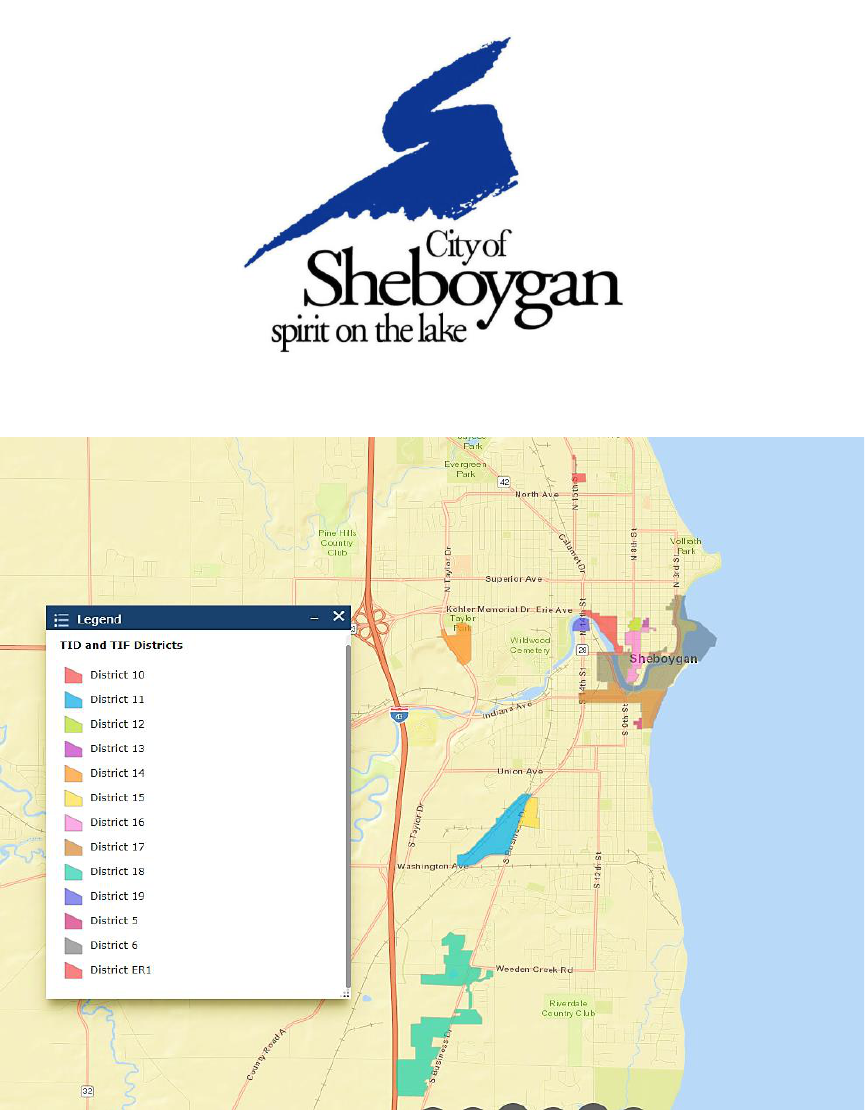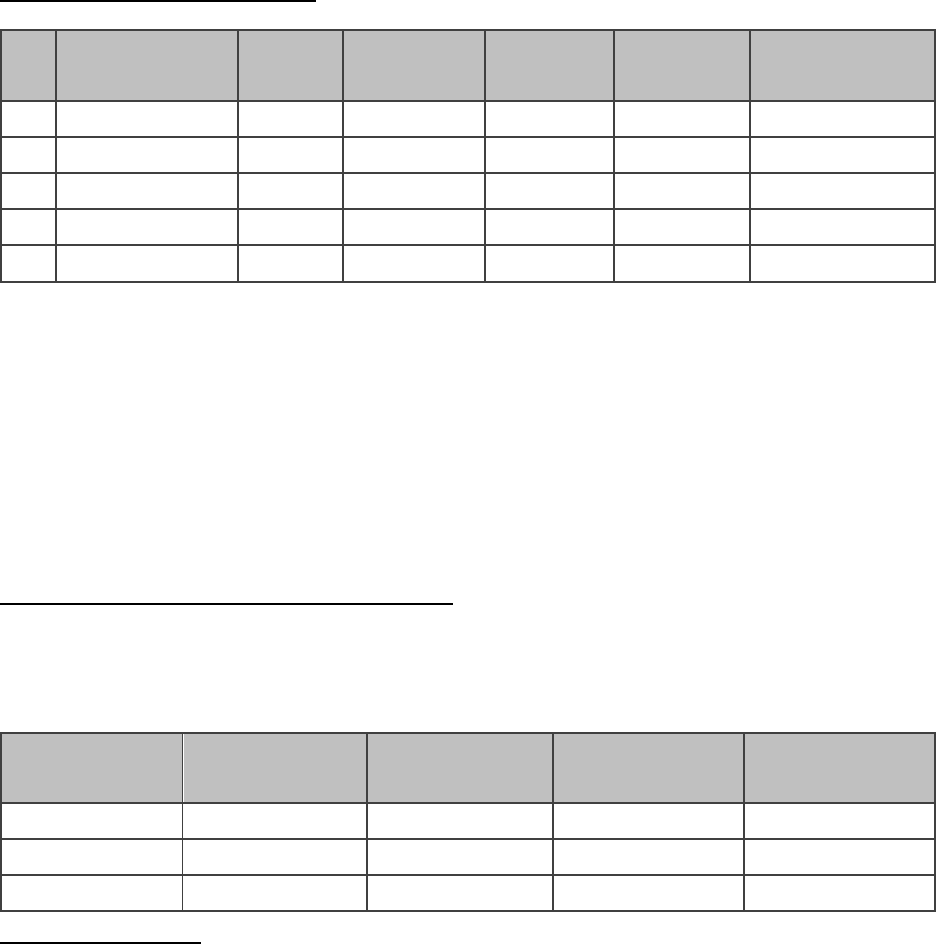
1
City of Sheboygan, Wisconsin
Tax Increment Financing (TIF) Policy
Adopted June 21, 2021
Sheboygan Tax Increment Financing Districts (TIDs)
2
Introduction
Tax Incremental Financing is a financing tool where cities can use the increased
property tax revenue from new development or redevelopment in an area (called
a TIF District or TID) in order to pay for public infrastructure projects or economic
development projects in the TID. TIF works by temporarily capturing a portion of
property tax revenues collected in the TID to pay for eligible project costs as
described in the TID project plan. When project costs have been repaid through tax
increments, the TID closes and the total value of properties in the TID are added to
the tax base of the city, county, and school district. TIF is the main economic
development tool available to Wisconsin cities.
Financial assistance from the City of Sheboygan TIF program for private
development or redevelopment projects shall be evaluated according to Wisconsin
law and this policy. Variations from this policy may be considered for projects that
provide extraordinary benefits to the community in terms of tax base, job creation
or retention, improvements to public infrastructure, or other advantages to the
Sheboygan economy.
The City of Sheboygan shall evaluate all requests for TIF assistance using the “but
for” standard and utilizing a financial gap analysis. Each project must demonstrate
that “but for” a TIF, the project would not be financially feasible. The financial gap
analysis should demonstrate the minimum amount of TIF assistance needed as gap
financing to make the project financially feasible.
The Common Council in its sole authority may approve or disapprove any TIF
requests as it deems appropriate. The goals, guidelines, and descriptions below
should not be seen as anything but goals and guidelines and do not bind the
Common Council in any way to approve or deny an individual request. Additionally,
approval or disapproval of any TIF request does not establish precedent obligating
the Common Council to approve or disapprove any future TIF requests.
3
Section 1: TIF Goals
1. Growing the property tax base.
2. Fostering the creation and retention of quality jobs for individuals of all
backgrounds and abilities.
3. Redeveloping blighted areas that are obsolete or detrimental to public
health and wellbeing.
4. Promoting infill development and redevelopment that can achieve highest
and best use of land.
5. Remediating contaminated brownfield sites.
6. Incentivizing the development of a range of workforce housing options that
can close the housing affordability gap.
7. Mitigating climate change and adapting to our changing environment.
8. Funding public improvements that enhance livability, improve the City’s
infrastructure, enhance the urban greenway, improve multi-modal
transportation options and access to employment areas, enrich aesthetics of
key areas and corridors within the City through the use of streetscaping and
art amenities, and boost the stormwater management capabilities.
9. Leveling the playing field for sites that are challenging to develop due to
extremely poor soil quality.
10. Implementing adopted City plans and policies, particularly the City’s
Comprehensive plan, Master plan and Neighborhood plans.
11. Ensuring that sufficient increment is available to fund public infrastructure
projects as described in TID project plans.
4
Section 2: TIF Policy Guidelines
1. Sheboygan will give preference to TIF assistance for projects that are
occurring on sites that are already developed (redevelopment projects) over
greenfield development projects which typically have lower costs.
2. All TIF considerations shall be consistent with approved TIF Project Plan(s)
(see Section 3).
3. If Sheboygan provides TIF assistance to developers, it will do so primarily
through developer-financed methods. Sheboygan may consider up-front TIF
incentives on a case-by-case basis where gap financing is required.
4. Sheboygan will consider TIF requests only after determining that “but for”
the TIF, the project would not be financially viable.
5. Sheboygan aims to minimize the percentage of increment applied to a
development project. Generally, the City of Sheboygan does not approve
increment financing for more than 15% of the project area’s total assessed
value.
6. For development projects that will include competitive funding resources
allocated by any state or federal agency, Sheboygan may evaluate TIF
assistance with the standards of the state or federal funding source and seek
to design incentives for job creation or retention. If economic incentives are
offered, there will be a job maintenance and lookback provision
requirement.
7. In special circumstances, Sheboygan may provide economic incentives for
job creation or retention. If economic incentives are offered, there will be a
job maintenance and lookback provision requirement.
8. Sheboygan will include lookback provisions on actual construction costs and
TIF-eligible expenses for all TIF agreements.
9. Sheboygan may require heightened design standards for TIF projects.
10. Developers shall pay TIF creation costs from TID consultant for site-specific
TIDs.
11. Developers shall make a good faith effort to work with local contractors on
development phase of the project.

5
Section 3: TIF Project Types & Costs
The following project types may be TIF eligible if they meet the City’s TIF Goals
(Section 1):
1. Projects that are consistent with the approved TIF Projects Plans.
2. Redevelopment projects, including but not limited to office, research &
development, medical uses, manufacturing, hospitality and leisure, housing,
and mixed-use projects.
The following project costs may be TIF eligible if they meet the City’s TIF Goals
(Section 1):
1. Public infrastructure necessary for the proposed project.
2. Demolition of existing structures for development projects.
3. Remediation of soils that are contaminated or remediation of soils that are
of poor quality for construction purposes.
4. Preservation and revitalization of historic buildings.
5. Structured parking that maximizes density on a site.
6. Extraordinary costs related to affordable housing development.
7. Whole building energy modeling (BEM) for new construction and building
retrofits.
8. Renewable energy, including solar photovoltaics, geothermal, and wind
energy.
9. Microgrid technology that can support renewable energy and energy
reliability.
10. Green roofs that include gardens that can capture and retain stormwater.
11. Blue roofs that capture and store stormwater to mitigate runoff effects.
12. Under-parking water retention systems that capture and store stormwater
to mitigate runoff effects.
13. Stormwater management best practices that are above the State mandate.
14. Purple pipe reclaimed water piping systems.
15. Site-specific public art projects.

6
The following project types are not TIF eligible
1. Developments that occur outside the TIF district.
2. Market rate housing on greenfield sites are not typically TIF eligible. Market
rate housing projects will be evaluated on a case-by-case basis and may be
considered for assistance to the degree they demonstrate a financial gap and
promote the City’s TIF goals articulated in Section 1.
3. Retail-only buildings on greenfield sites (retail stores, service-oriented
retailers like daycares, etc.).
4. Buildings that are already constructed.
5. Developments that are exempt from the payment of property taxes.
The following project costs are not TIF eligible
1. Land costs that exceed market land costs.
2. Ordinary or typical development costs that are normally provided in the
market for the type of land use that is being proposed or that are required
to meet City or State requirements or codes. Examples could include (but are
not limited to): 1) costs related to meeting code requirements; 2) costs
related to meeting City stormwater management requirements.
3. Energy efficiency improvements (including high-efficiency windows or
shadings, energy efficient appliances, LED lighting, enhanced insulation, etc.)
within a building. These are expected in all TIF projects but they are not TIF-
eligible costs.
4. City fees (impact, permits, park improvement, stormwater management,
etc.).
5. TIF may not pay for infrastructure that is normally paid for by special
assessments or other city charges.
6. Other costs that are deemed to be normal development costs.

7
Section 4: Application and Approval Process
1. Pre-Application Meeting: The developer shall meet with City staff to discuss
the project in concept including the need for TIF financing, potential TIF
eligible costs, project timeline, and economic benefits.
2. Application and Review Fee: If the developer wishes to proceed with a
request for TIF financing they shall submit a TIF request letter and completed
application form along with a TIF Review Fee of $1,000 which will be used to
cover the cost for staff and City consultants in reviewing the TIF request over
the 3-5-month review process. The TIF Review Fee is non-refundable.
Additional costs that arise during the application process will also be covered
by the applicant. These costs would cover any outside legal assistance,
outside financial assistance or other services. In submitting the TIF request
form, the applicant is agreeing to cover these and any other additional costs.
As part of the application, the developer shall submit a proforma for the
project showing the total sources and uses of funds, anticipated project
valuation, and projected rate of return.
3. Staff Review and Recommendation: The City’s TIF team will review the
request with assistance from the City’s consultants (TIF Consultant, City
Engineer, Financial Advisor, and City Attorney) and from the City Assessor as
needed. Depending on the complexity of the project, the developer may be
invited in for additional meetings with the City’s TIF Project Management
Team (PMT) or TIF staff.
4. Common Council Conceptual Review: The Common Council will meet to
review the TIF request. The Common Council may meet with the developer
in open session to ask questions regarding the request. The Common Council
will then have the opportunity to meet in closed session, as appropriate,
without the developer to discuss negotiations of the terms of the TIF
agreement. If appropriate, the Common Council may take a vote in closed
session and direct staff to start negotiating the developer’s agreement for
the project.

8
5. Common Council Conceptual Review: The Common Council will review the
terms and direction and Finance Committee recommendation and take
action on the conceptual approval of the terms of the TIF agreement.
6. Drafting of TIF Agreement: Following conceptual approval by the Common
Council, staff will work with the City Attorney to draft the formal TIF
agreement based on the terms and the direction of the Common Council.
7. TIF Agreement Approval: The TIF agreement shall be introduced at a
Common Council meeting and referred to the Finance and Personal
Committee. The Finance and Personal Committee will review the TIF
agreement and make a recommendation to the Common Council who shall
take action to approve or reject the agreement.
8. Lookback and Review of TIF-Eligible Costs: Following completion of the
project, the developer shall submit the final action sources and uses (costs)
for the project per the agreement. In addition, the developer shall provide
documentation of the actual amount of TIF-eligible costs. The amount of the
TIF incentive shall be limited to the actual amount of TIF-eligible costs.
Project Requirements
All developers requesting TIF assistance must demonstrate that:
1. The project is not financially feasible without the use of the requested TIF
funding.
2. The TIF request complies with Wisconsin statutes and the TIF District Project
Plan.
Project Evaluation Criteria
The following criteria will be used in evaluating requests for TIF assistance. Other
factors may be considered as well on a project by project basis.
• Does the project conform to existing plans and zoning?
• How does the project increase and improve the City’s tax base?
• What portion of the tax increment is applied to the project compared to total
TIF district?
• What is the economic impact of the project including job creation and
retention?
9
• Does the project support the City’s affordable housing and sustainability
goals?
• What impact would the project have on current City business?
• What are the qualifications of the developer and the development team?
• What level of private equity and financing is included in the project budget?
• Does the project rely on reasonable assumptions of real property value
increases?
• Would the proposed project assist in achieving other policy goals established
by the Common Council?

10
City of Sheboygan, Wisconsin
Tax Increment Financing (TIF) Request Application Form
Please complete and submit the following information to the Department of
City Development for a more detailed review of the feasibility of your request
for Tax Increment Financing (TIF) assistance.
Applicant Information
Name of Applicant: ________________________________________________
Business Name and Address:________________________________________
________________________________________________________________
________________________________________________________________
Primary Contact: __________________________________________________
Phone Number: ___________________ Email Address: ___________________
Type of Business Entity: ____________________________________________
Property Information
Address of the Proposed Project: _____________________________________
Parcel Number(s):_________________________________________________
Currently, does the applicant own or lease the property? (Check one)
____Owner ____Renter ____Neither
At project completion, will the applicant own, lease or convert the property to
condo ownership? (Check one)
____Own ____Lease ____Convert to Condo Ownership

11
At project completion, who will occupy (operate business on) the site? (Check
one)
____Owner ____Renter ____Both
If the applicant is the current or prospective tenant of the property, attach a
description of the premises to be leased (legal description, floor plan, etc).
Evidence of Site Control
A. If the Applicant owns the project site, attach a copy of the applicant’s deed. Also
indicate: Mortgage Holder(s): ______________________________________
B. Total annual mortgage payment (principal & interest): $___________________
C. Total outstanding balance of existing mortgage(s): $______________________
A. Name, address, and phone numbers of other persons or entities having an
ownership interest in the property to be redeveloped, if applicable:
B. If the Applicant has a contract or option to purchase the project site, attach a
copy of the purchase or option contract. Also indicate:
Date Contract was signed: _______/_______/________
Closing/expiration date: _______/_______/________
C. If the Applicant currently leases or will lease the project site, attach a copy of the
lease or lease option contract. Also indicate:
Legal name of Owner as noted on the deed(s):_____________________________
Name of person who signed lease for Tenant (lessee): ______________________
Landlord/Owner’s name and address: ____________________________________
___________________________________________________________________
Owner Affidavit: If the applicant leases or plans to lease the property, have the
owner (and all entities having ownership interest in the property) sign an Owner’s
Consent Letter.

12
Project Description
Describe the project and proposed use:___________________________________
___________________________________________________________________
___________________________________________________________________
___________________________________________________________________
___________________________________________________________________
Is the proposed project consistent with the existing zoning of the property?
(Check One) ____Yes ____No
If no, what zoning change will be requested? ______________________________
___________________________________________________________________
Land Area (acreage) of project site:
Current: ________ acres
Proposed: _________ acres.
Building Area in square feet or Acres (circle the unit you used) of project building
Gross Net Leasable
Current: ____________ Sq. Ft / Acres _____________Sq. Ft / Acre
Proposed: ____________Sq. Ft / Acres _____________Sq. Ft / Acre
Number of Stories___________ Number of Units ___________

13
Residential Unit Breakdown
Unit Type
# of
Units
# of
Bedrooms
Avg. Sq.
Ft.
Avg. Rent
Avg. Sale
Price*
A
B
C
D
E
*If condo project
Utilities included in apartment rent (check all that apply):
None ______ Electric _____ Heat _____ Other (Specify): _______________
Additional Costs
Parking ______ Storage______ Other (Specify): ____________________
Job Creation and Retention Information
List the current projected number of part-time and full-time jobs in the City of
Sheboygan before and after completion.
Current Jobs
Projected
Jobs
Average
Wages/Salary
Average Total
Compensation
Full-Time
Part-Time
Total
Projected Budget
Type of assistance being requested: (Check One)
Developer-Financed TIF Incentive ___
City-Financed (Upfront) TIF Incentive ___
Waiver of Impact Fees (For affordable housing projects) ___
Other (Describe): _______________________________________________

14
Indicate the total amount of TIF assistance requested: $ _____________________
Anticipated assessed value of the project at completion: $ ___________________
Project Budget Sources and Uses of Funds
SOURCE OF FUNDS
AMOUNT
Private Financing
Secondary Financing
Developer Equity
Investor Equity
Grants
TIF Assistance
Other:
Other:
Other:
TOTAL SOURCES
USES OF FUNDS
AMOUNT
Property Acquisition
Demolition
Environmental
Public Infrastructure
Hard Construction Cost
Architect & Engineering fees
Other Soft Costs & Permits
Financing Costs
Development Fee
Contingency
Other:
Other:
TOTAL COSTS
Please attach a detailed project proforma showing projected revenues,
expenditures, net operating income, and anticipated after-TIF rate of return.

15
TIF-Eligible Costs
Only extraordinary costs beyond those of a typical development will be
considered as potential TIF-eligible costs. For each item where TIF funding is
requested list the total estimated cost of the item, the normal development cost,
and the portion of the cost that is being requested for TIF funding.
Item
Total Cost
Estimate
Normal
Development
Cost
Requested TIF-
Eligible Cost
Total
Project Financing
Private Financing Lender: ______________________________________________
Loan Amount $ ___________________ Interest Rate:__________
Preapproved? Yes____ No____
TIF Loan Lender: ____________________________________________________

16
Loan Amount $___________________Interest Rate: ___________
Preapproved? Yes____ No____
If yes, what programs:________________________________________________
___________________________________________________________________
Application status:___________________________________________________
___________________________________________________________________
Likelihood of award:__________________________________________________
___________________________________________________________________
Other funding: ______________________________________________________
Signature
I, the undersigned, affirm that the project descriptions, numerical and financial
estimates, and all other information I have provided in this application are true
and complete to the best of my knowledge. I have read and understood the
requirements described in this application. I understand this application and the
supporting documents are considered public records and may be subject to
disclosure under Wisconsin’s Public Records laws. Furthermore, I certify that I am
authorized to initiate the TIF application process on behalf of the project
described. I agree to cover any and all costs involved in processing this
application.
Signed: _____________________________ Date: _____________________
Title: _______________________________
Legal Disclaimer
Completion of this application does not entitle the applicant to financial
assistance. Any such assistance must be approved by the appropriate City boards,
committees, authorities, and the Common Council.
17
Please attach:
• A letter describing the project, its impact, and the need for TIF assistance.
• A detailed proforma showing projected revenues, expenses, net operating
income, and the after-TIF assistance anticipated rate of return (see
example).
• Loan pre-approval or commitment letter (if applicable).
A non-refundable TIF application fee in the amount of $1,000 is required with
this application to reimburse the cost of City TIF staff and consultants in
reviewing the TIF request.
*The Developer will be responsible for the creation cost of any site-specific TIF.
